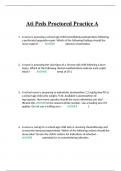Summary
Summary Learning theories 4.2 methods
- Course
- Institution
For methodology in Learning theories, it has summaries of different types of observations, animal ethics and statistical test called chi-squared, all have a summary of evaluation points.
[Show more]












